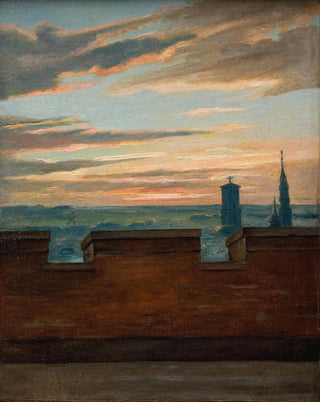Art print | View of Copenhagen at sunset - Martinus Rørbye


View from behind

Frame (optional)
Art print of Copenhagen at sunset view - Martinus Rørbye – Captivating introduction
The canvas "Copenhagen at sunset" by Martinus Rørbye is an invitation to immerse oneself in the melancholic and poetic atmosphere of the Danish capital. This masterpiece, which captures the magic of twilight over the calm waters of the harbor, evokes a sense of serenity and wonder. Through delicate shades of warm and cool colors, Rørbye manages to convey not only the beauty of the landscape but also a palpable emotion, that of a moment suspended in time. The work transports us to a time when nature and urban life coexisted in perfect harmony, offering a romantic vision of a vibrant city, while hinting at the shadows of a more complex reality.
Style and uniqueness of the work
Martinus Rørbye's style is distinguished by its intimate approach and its ability to play with light. In "Copenhagen at sunset," each brushstroke seems to tell a story, each reflection on the water becomes visual poetry. The color palette, ranging from vibrant oranges to deep blues, creates an atmosphere that is both warm and mysterious. Rørbye uses light not only as a technical tool but also as a means of expression, allowing the viewer to feel the softness of Danish twilight. The composition of the work, with its flowing lines and organic shapes, guides the eye toward the horizon, inviting contemplation. This uniqueness in the treatment of light and colors makes this work a true jewel of Nordic romanticism, where nature and architecture meet in a harmonious dance.
The artist and his influence
Martinus Rørbye, an emblematic figure of the 19th century, knew how to mark his era with his unique perspective on the world around him. Born in Copenhagen, he was influenced by the Romantic movement, which advocated the expression of emotions and a return to nature. His training at the Royal Danish Academy of Fine Arts in Copenhagen allowed him to develop his own style, while integrating elements of realism and neoclassicism. Rørbye was

Matte finish

View from behind

Frame (optional)
Art print of Copenhagen at sunset view - Martinus Rørbye – Captivating introduction
The canvas "Copenhagen at sunset" by Martinus Rørbye is an invitation to immerse oneself in the melancholic and poetic atmosphere of the Danish capital. This masterpiece, which captures the magic of twilight over the calm waters of the harbor, evokes a sense of serenity and wonder. Through delicate shades of warm and cool colors, Rørbye manages to convey not only the beauty of the landscape but also a palpable emotion, that of a moment suspended in time. The work transports us to a time when nature and urban life coexisted in perfect harmony, offering a romantic vision of a vibrant city, while hinting at the shadows of a more complex reality.
Style and uniqueness of the work
Martinus Rørbye's style is distinguished by its intimate approach and its ability to play with light. In "Copenhagen at sunset," each brushstroke seems to tell a story, each reflection on the water becomes visual poetry. The color palette, ranging from vibrant oranges to deep blues, creates an atmosphere that is both warm and mysterious. Rørbye uses light not only as a technical tool but also as a means of expression, allowing the viewer to feel the softness of Danish twilight. The composition of the work, with its flowing lines and organic shapes, guides the eye toward the horizon, inviting contemplation. This uniqueness in the treatment of light and colors makes this work a true jewel of Nordic romanticism, where nature and architecture meet in a harmonious dance.
The artist and his influence
Martinus Rørbye, an emblematic figure of the 19th century, knew how to mark his era with his unique perspective on the world around him. Born in Copenhagen, he was influenced by the Romantic movement, which advocated the expression of emotions and a return to nature. His training at the Royal Danish Academy of Fine Arts in Copenhagen allowed him to develop his own style, while integrating elements of realism and neoclassicism. Rørbye was






